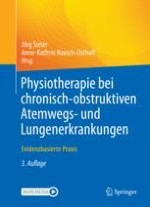Zusammenfassung
Die sekundäre Atemmuskulatur spielt eine nicht zu unterschätzende Rolle für die Atemmechanik des Menschen. Vor allem bei Veränderungen der Compliance von Thorax und Lunge ändern sich nicht nur die mechanischen Gegebenheiten für das Zwerchfell, sondern auch für die sekundäre Atemmuskulatur. Besonders bei chronischen pulmonalen Krankheitsbildern beobachtet man eine zunehmende Relevanz der Atemhilfsmuskulatur, um Ein- und Ausatmung aktiv zu unterstützen. Mit der neuen Anforderung entstehen auch intramuskulär neue Längen- und Spannungsverhältnisse auf Basis propriozeptiver Rückkopplungssysteme. Bei dauerhaftem Bestehen der vermehrten Anforderung, im Sinne einer Fehl- oder Überbelastung reagiert die quergestreifte Muskulatur mit Dysbalance. In diesem Kapitel werden die unterschiedlichen Formen der muskulären Dysbalance und deren Auswirkungen dargestellt. Weiter werden Ursachen für muskuläre Dysbalance der Atemhilfsmuskulatur aufgezeigt und in Bezug zu gängigen pulmonalen Krankheitsbildern gesetzt. Ein anschaulicher Praxisteil geht auf die Untersuchungs- und Behandlungsmöglichkeit ein.














